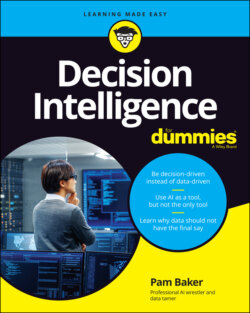Читать книгу Decision Intelligence For Dummies - Pamela Baker - Страница 49
The limits of math-only approaches
ОглавлениеWhen you come right down to it, math isn’t much of a strategist. If your business strategy involves putting all your eggs in the mathematical basket, you’re staking your business’s future on a naïve strategy that more likely than not will underperform. That’s what typically happens when strategies depend too much on quantitative values.
It’s nonetheless true that quantitative values have fueled (and continue to fuel) the harvesting of big data low hanging fruit. That is to say that many of the algorithms that have been used until this point do have value and will continue to have value going forward — but only in certain circumstances. For example, an algorithm that predicts when a mechanical part will reach the end of its usefulness is a reliable indicator of when that part should be replaced. Such decision triggers — or decision recommendations, if you prefer a different term — will continue to be helpful. That being said, without the added qualitative inputs for balance and context in decision-making, pure math tends to go a bit sideways in real-world applications.
So, what could act as qualitative measures in decision-making? For the most part, they are things you associate with human qualities, such as behaviors, emotional responses, talents, instincts, intuitive intelligence, experience, cultural interpretations, and creativity. Folks often refer to them as soft skills, but Google’s Cassie Kozyrkov hits the nail on the head when she says that it’s better to think of these skills as “the ‘hardest to automate.’”
I’m all for cultivating the soft skills, as my arguments throughout this book make clear. But I’m not about to throw the baby out with the bathwater. The points I make here in no way negate or contradict the usefulness of math in data science, data analytics, or decision processes. You can’t just skip the math in decision intelligence — nor should you want to. The good news is that much of the math you need has already been built into many of the more useful analytical tools available to you, making them much less troublesome and far easier to use. (I tell you more about tools with automated math later, in Chapter 7.) For now, the point is that math alone does not a decision make.
Decision intelligence adds to the data sciences; it doesn’t lessen the value of the associated disciplines, experiences, tools, or lessons learned thus far in scalable decision-making. Rather, it involves a rethinking of how and when to use those disciplines, experiences, tools, and lessons learned thus far in the decision-making process. Make no mistake; math and algorithms remain important cornerstones in many of the tools. However, math and algorithms are decoupled from the decision-making process in the user interface and pushed to the background in emerging decision intelligence and related tools.
Think of decision intelligence as the next logical, evolutionary step in data democratization and interpretation.
